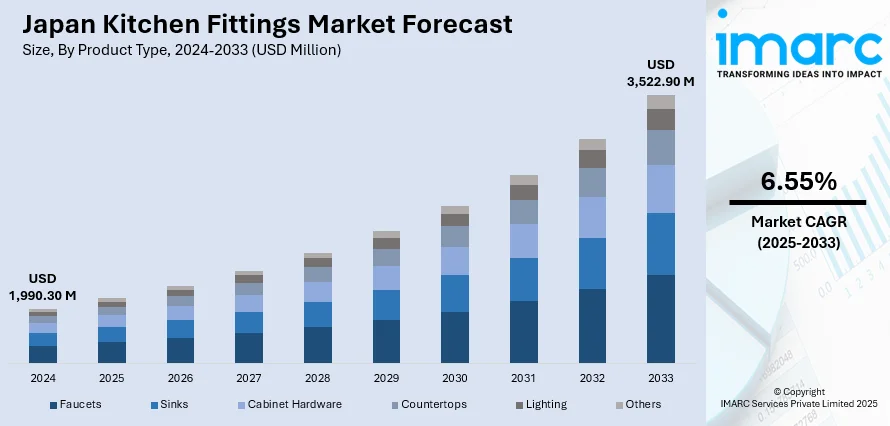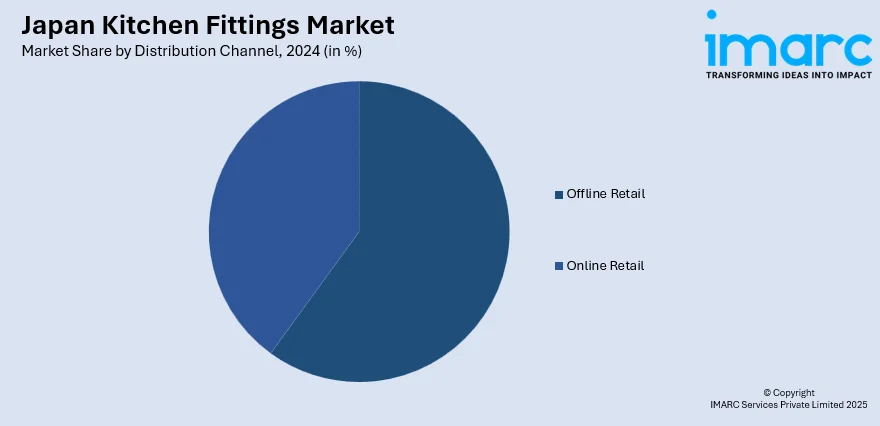
Japan Kitchen Fittings Market Size, Share, Trends and Forecast by Product Type, Material, Distribution Channel, End User, and Region, 2025-2033
Japan Kitchen Fittings Market Overview:
The Japan kitchen fittings Market size reached USD 1,990.30 Million in 2024. Looking forward, IMARC Group expects the market to reach USD 3,522.90 Million by 2033, exhibiting a growth rate (CAGR) of 6.55% during 2025-2033. The market is fueled by driven by technological innovation and consumer demand for convenience and efficiency. Strong preference for smart, energy-efficient, and space-saving built-in appliances, reflecting compact living spaces and the needs of dual-income families. Expansion of e-commerce is further boosting the increase in Japan kitchen fittings market share.
|
Report Attribute
|
Key Statistics
|
|---|---|
|
Base Year
|
2024 |
|
Forecast Years
|
2025-2033
|
|
Historical Years
|
2019-2024
|
| Market Size in 2024 | USD 1,990.30 Million |
| Market Forecast in 2033 | USD 3,522.90 Million |
| Market Growth Rate 2025-2033 | 6.55% |
Japan Kitchen Fittings Market Trends:
Smart Integration and IoT-Enabled Appliances
Japan's market for kitchen fittings is dominated by the infusion of intelligent technology. Customers are moving toward appliances with convenience and efficiency, like intelligent refrigerators, ovens, and dishwashers with Internet of Things (IoT) connectivity. These devices can track food inventory, provide recipe suggestions, and maximize power consumption. For example, in 2024, LG launched a microwave oven with a 27-inch LCD touchscreen and integrated speakers, emphasizing on the entertainment and kitchen cooking technology. The trend is especially desirable among double-income families and young consumers who seek to save time and have innovative solutions in the kitchen. The integration of AI and IoT into kitchen devices is transforming consumer needs and fueling the Japan kitchen fittings market growth.

To get more information on this market, Request Sample
Compact and Multifunctional Designs
With limited living space in Japan, there is increasing demand for compact and functional kitchen fittings. People are looking for appliances that do not take up a lot of space but still offer functionality. Space-saving products such as all-in-one cookers, foldable dishwashers, and modular storages are on the rise. A good example is Zojirushi rice cookers that are famous for their capacity to prepare great rice and can also steam and slow cook. These cookers fit perfectly in small kitchens. This is due to the minimalist culture that dominates in Japan, where simplicity and efficiency are sought after. Manufacturers are countering by making products that are not just space-efficient but also good-looking, which is in line with Japanese taste for neat and tidy kitchen spaces.
Focus on Sustainability and Energy Efficiency
Sustainability is a major impetus for Japan's kitchen fittings market. Consumers are becoming environmentally conscious and making energy-efficient appliances, which save on electricity and water, a popular choice. Government incentives and policies, like rebates for exchanging old appliances with new energy-efficient ones, are nudging it forward. Companies are adding features like inverter technology in refrigerators and induction cooking in stoves to make their appliances more energy efficient. There is also an increased use of appliances made from sustainable materials, like recycled plastics and BPA-free parts. This emphasis on sustainability resonates with international environmental objectives and anticipates the expectations of Japanese consumers in deciding what to buy, emphasizing eco-friendly products.
Japan Kitchen Fittings Market Segmentation:
IMARC Group provides an analysis of the key trends in each segment of the market, along with forecasts at the country and regional levels for 2025-2033. Our report has categorized the market based on product type, material, distribution channel, and end user.
Product Type Insights:
- Faucets
- Sinks
- Cabinet Hardware
- Countertops
- Lighting
- Others
The report has provided a detailed breakup and analysis of the market based on the product type. This includes faucets, sinks, cabinet hardware, countertops, lighting, and others.
Material Insights:
- Stainless Steel
- Brass
- Ceramic
- Glass
- Wood
- Others
A detailed breakup and analysis of the market based on the material has also been provided in the report. This includes stainless steel, brass, ceramic, glass, wood, and others.
Distribution Channel Insights:

- Offline Retail
- Online Retail
A detailed breakup and analysis of the market based on the distribution channel has also been provided in the report. This includes offline retail and online retail.
End User Insights:
- Residential
- Commercial
The report has provided a detailed breakup and analysis of the market based on the end user. This includes residential and commercial.
Regional Insights:
- Kanto Region
- Kansai/Kinki Region
- Central /Chubu Region
- Kyushu-Okinawa Region
- Tohoku Region
- Chugoku Region
- Hokkaido Region
- Shikoku Region
The report has also provided a comprehensive analysis of all the major regional markets, which include Kanto Region, Kansai/Kinki Region, Central /Chubu Region, Kyushu-Okinawa Region, Tohoku Region, Chugoku Region, Hokkaido Region, and Shikoku Region.
Competitive Landscape:
The market research report has also provided a comprehensive analysis of the competitive landscape. Competitive analysis such as market structure, key player positioning, top winning strategies, competitive dashboard, and company evaluation quadrant has been covered in the report. Also, detailed profiles of all major companies have been provided.
Japan Kitchen Fittings Market News:
- In March 2025, At the EXPO 2025 in Osaka, Kansai, Japan, Zojirushi intended to sell onigiri made with rice prepared in the Enbudaki Rice Cooker inside the Osaka Restaurant Management Association Pavilion. Expo 2025 will have the subject "Designing Future Society for Our Lives." Delivering wonderful rice is Zojirushi's mission, and their long-term objective is to reach more people worldwide who enjoy rice.
Japan Kitchen Fittings Market Report Coverage:
| Report Features | Details |
|---|---|
| Base Year of the Analysis | 2024 |
| Historical Period | 2019-2024 |
| Forecast Period | 2025-2033 |
| Units | Million USD |
| Scope of the Report |
Exploration of Historical Trends and Market Outlook, Industry Catalysts and Challenges, Segment-Wise Historical and Future Market Assessment:
|
| Product Types Covered | Faucets, Sinks, Cabinet Hardware, Countertops, Lighting, Others |
| Materials Covered | Stainless Steel, Brass, Ceramic, Glass, Wood, Others |
| Distribution Channels Covered | Offline Retail, Online Retail |
| End Users Covered | Residential, Commercial |
| Regions Covered | Kanto Region, Kansai/Kinki Region, Central /Chubu Region, Kyushu-Okinawa Region, Tohoku Region, Chugoku Region, Hokkaido Region, Shikoku Region |
| Customization Scope | 10% Free Customization |
| Post-Sale Analyst Support | 10-12 Weeks |
| Delivery Format | PDF and Excel through Email (We can also provide the editable version of the report in PPT/Word format on special request) |
Key Questions Answered in This Report:
- How has the Japan kitchen fittings market performed so far and how will it perform in the coming years?
- What is the breakup of the Japan kitchen fittings market on the basis of product type?
- What is the breakup of the Japan kitchen fittings market on the basis of material?
- What is the breakup of the Japan kitchen fittings market on the basis of distribution channel?
- What is the breakup of the Japan kitchen fittings market on the basis of end user?
- What is the breakup of the Japan kitchen fittings market on the basis of region?
- What are the various stages in the value chain of the Japan kitchen fittings market?
- What are the key driving factors and challenges in the Japan kitchen fittings market?
- What is the structure of the Japan kitchen fittings market and who are the key players?
- What is the degree of competition in the Japan kitchen fittings market?
Key Benefits for Stakeholders:
- IMARC’s industry report offers a comprehensive quantitative analysis of various market segments, historical and current market trends, market forecasts, and dynamics of the Japan kitchen fittings market from 2019-2033.
- The research report provides the latest information on the market drivers, challenges, and opportunities in the Japan kitchen fittings market.
- Porter's five forces analysis assist stakeholders in assessing the impact of new entrants, competitive rivalry, supplier power, buyer power, and the threat of substitution. It helps stakeholders to analyze the level of competition within the Japan kitchen fittings industry and its attractiveness.
- Competitive landscape allows stakeholders to understand their competitive environment and provides an insight into the current positions of key players in the market.
Need more help?
- Speak to our experienced analysts for insights on the current market scenarios.
- Include additional segments and countries to customize the report as per your requirement.
- Gain an unparalleled competitive advantage in your domain by understanding how to utilize the report and positively impacting your operations and revenue.
- For further assistance, please connect with our analysts.
 Request Customization
Request Customization
 Speak to an Analyst
Speak to an Analyst
 Request Brochure
Request Brochure
 Inquire Before Buying
Inquire Before Buying




.webp)




.webp)












